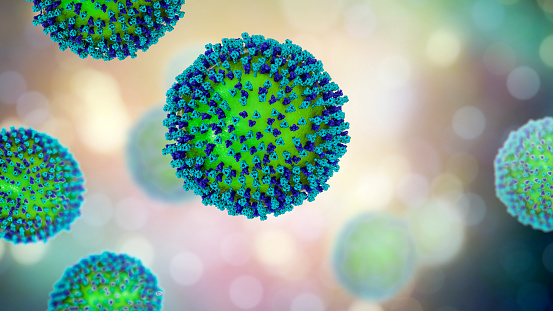Publication of a scientific article as part of the AFROSCREEN project “Viral etiology of measles-like rash in Guinean children during the COVID epidemic in 2022”
Publication of a scientific article as part of the AFROSCREEN project “Viral etiology of measles-like rash in Guinean children during the COVID epidemic in 2022”

Covid‐19 in West Africa masked outbreaks of vaccine‐preventable diseases such as the measles epidemic in children in Guinea in 2021–2022 characterized by a lack of confirmation of suspected clinical cases. During weeks 13–22 of 2022, saliva samples were collected from 213 children (3–60 months old) with measles‐like symptoms within the St Gabriel dispensary in Conakry. Samples were processed in Virus Transport Medium (VTM) and tested on the same day by triplex reverse transcriptase ‐real‐time polymerase chain reaction for Measles, Rubella and RNaseP.
Samples were also tested for HHV6 and Parvovirus B19, viruses causing clinical signs similar to measles. We confirmed 146 (68.5%) measles cases, 27 (12.7%) rubella, 5 (2.3%) double‐positive measles‐rubella, 35 (16.4%) HHV‐6 and 8 (3.75%) Parvovirus B19. To test the assay’s robustness, 27 samples were kept at 26–30°C. Measles and rubella were still detected after 7 days at 26–30°C, and after 21 days measles and rubella were still detectable in all samples but one. Sequencing indicated the circulation of the B3 measles genotype, as expected in West Africa. This study highlights the robustness of the measles/rubella diagnostic test on saliva samples stored in VTM. The high level of rubella detection questioned the single valence measles vaccination strategy.
Covid‐19 in West Africa masked outbreaks of vaccine‐preventable diseases such as the measles epidemic in children in Guinea in 2021–2022 characterized by a lack of confirmation of suspected clinical cases. During weeks 13–22 of 2022, saliva samples were collected from 213 children (3–60 months old) with measles‐like symptoms within the St Gabriel dispensary in Conakry. Samples were processed in Virus Transport Medium (VTM) and tested on the same day by triplex reverse transcriptase ‐real‐time polymerase chain reaction for Measles, Rubella and RNaseP.
Samples were also tested for HHV6 and Parvovirus B19, viruses causing clinical signs similar to measles. We confirmed 146 (68.5%) measles cases, 27 (12.7%) rubella, 5 (2.3%) double‐positive measles‐rubella, 35 (16.4%) HHV‐6 and 8 (3.75%) Parvovirus B19. To test the assay’s robustness, 27 samples were kept at 26–30°C. Measles and rubella were still detected after 7 days at 26–30°C, and after 21 days measles and rubella were still detectable in all samples but one. Sequencing indicated the circulation of the B3 measles genotype, as expected in West Africa. This study highlights the robustness of the measles/rubella diagnostic test on saliva samples stored in VTM. The high level of rubella detection questioned the single valence measles vaccination strategy.